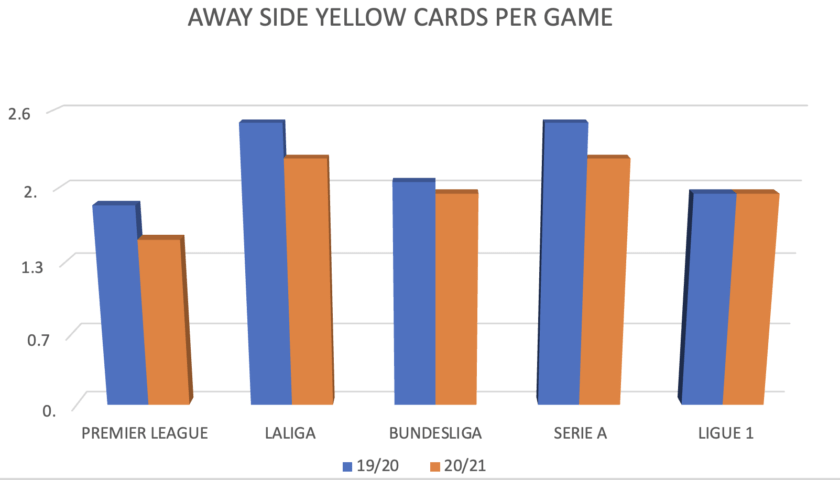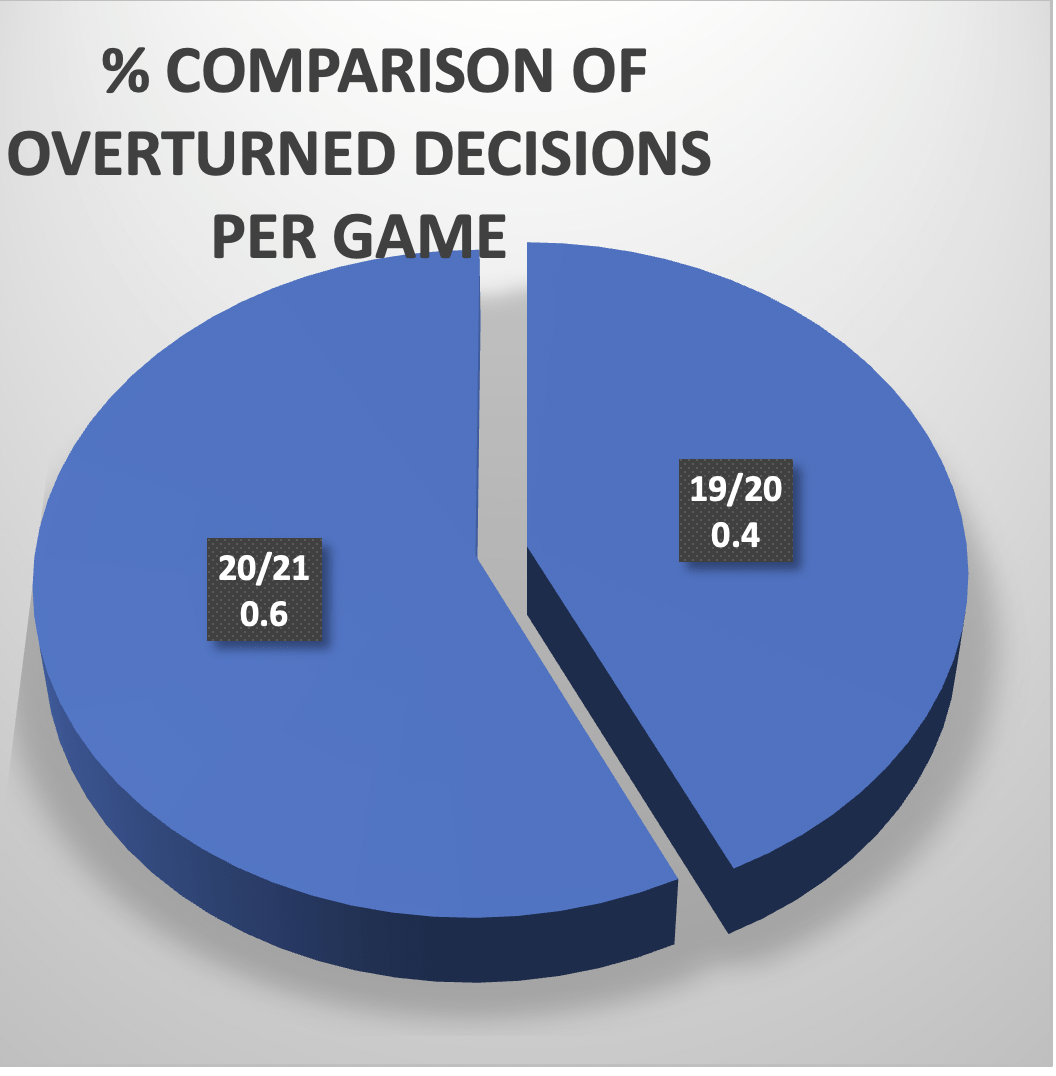The restrictions permitting a handful of people to attend professional football matches have certainly had a degree of negative impact on the experience of players and fans. However, one group who may be appreciating the relative silence are the referees. Mike Dean and co can finally officiate without, let’s face it, a relentless barrage of insults and ‘colourful’ abuse. Undoubtedly, a professional referee will be rigorously trained to ignore the slurs that are endlessly thrown their way. Yet, there is evidence to suggest that, even subconsciously, the crowd impacts their performance.
Initially, most people would intuitively assume that crowds, being present and vocal, influence referees. Accordingly, without crowds, there should be a measurable and apparent difference. A referee’s performance can, broadly speaking, be broken down into two main components: – the sheer number of ‘cards’ brandished for violations (red or yellow) and the quality of their overall ‘decision making.’ In more depth, these two components will be explored using statistical records of both cards issued and VAR decisions overturned, pre and during Covid -19.
Cards issued -The Crowd factor
Pre-Covid, it is critical to highlight that a crowd and full stadiums may affect the number of cards a referee gives to a particular side. Research by Andres Picazo-Tadeo highlights how officials are more likely to give a yellow card to an away side, irrespective of the number of fouls committed. It could be speculated that, after a foul has been committed, the level of noise from the home crowd could sway their thinking; Potentially making them portray a foul as more severe than it is. Effectively, the noise of the crowd is a cue for the seriousness of a foul. Di Corrado and Tiziano Agostini further highlight the concept of ‘social influence’ on referees. Officials are a target for home crowds to exert their frustration upon. To avoid this frustration, referees may conform to prevent further abuse or frustration coming from the crowd. Therefore, 50/50 decisions on fouls and yellow and red cards could be influenced heavily by the crowd. ([i]) ([ii])
An interview with Championship Assistant Referee and Referee’s World Podcast co-host Richard Melinn on the effects of crowds on referees proved revealing. [iii]
Melinn said: “The crowd are watching everything you do; as an assistant, they watch and wait every time you should put your flag up.”
“Every time you blow the whistle, there is a comment; every time you don’t blow the whistle, there’s a comment; There’s a collective audience who demand and expect.”
ex championship assistant referee Richard Melinn
Furthering Andres Picazo-Tadeo’s research on how referees treat the away side, it is interesting to gather figures of yellow cards issued during the pandemic. A start point is to take the average for yellow cards given to away teams in Europe’s top five leagues. These figures are then compared to the 2019/20 season, where grounds were packed, and the concept of home crowd social influence could have been in full swing. (Stats retrieved from whoscored.com) [iv]

As the chart above displays, there has been a decrease in the number of yellow cards that have been given to the away-side in empty stadia compared to when they were full. More specifically, referees are giving in Europe’s top five Leagues 0.3 yellow cards less per game to the away side, on average. This may be as a result of less pressure from the stands. Therefore, this supports the idea of a home crowd coercing a referee to punish an opposition player. Although, when I spoke to former Assistant Richard Melinn, he made me aware that recent adaptations in refereeing techniques could have an impact.
Melinn said: “There is a collective approach to managing the game better now and not dishing out yellow cards on such a regular basis.
“I do feel that this collective approach is having an impact, and as much as there could be a link [to stadiums being empty], more research would have to be done.”
Decision making – The Crowd factor
The reduction in yellow cards to away sides may not be the only difference for the men in black this season. Has their decision-making been as sharp and precise as previous seasons?
Writing for the Daily Mail in June last year, former Premier League referee Mark Clattenburg felt that the lack of intensity could lead to referees getting complacent with their decision making: “The biggest challenge for referees in a behind-closed-doors environment will be the danger of relaxing too much.
Embed from Getty Images“When that crowd noise is there, you can feel the pressure, the blood flows, and the senses are heightened,” said Clattenburg. [i]
The former Premier League official alluded to an account by German referee Deniz Aytekin, whose heart rate, during the notorious derby between Dortmund v Schalke, was ‘extremely low’ compared to when the stands were full, and crowds were fanatically chanting.
Embed from Getty Images‘There is a fear – referees will be too calm, and perhaps that is when a mistake will happen, Clattenburg added. 20
Clattenburg’s words were also echoed in my interview with Richard Melinn, who said: “As match officials, we feed off excitement and adrenaline.”
“The occasion makes you puff up a bit; you have to have a calm and calculated approach.”
Richard Melinn
To further this argument, the introduction of VAR has allowed assessment, in microscopic detail, of how many errors referees are making per game. With help from ESPN statistics, last season saw 109 VAR overturns, which, over a Premier League season, is around 0.28 VAR overturns per game. At present, 259 Premier League games have taken place in the 20/21 season. There have been 90 VAR overturns, giving an average of 0.4 per game. This could demonstrate that Clattenburg’s suggestion about referees becoming too relaxed and making more mistakes is very much related to the absence of crowds. [ii]

As this chart describes, there has been a 14% increase in VAR overturning a referee’s decision per game this season compared to last season. In a very similar way to players performing better when they have high arousal stimulated from the crowd, could referees be more alert when a crowd is present? Does the emotion of a packed stadium heighten the senses and therefore improve decision-making? Not only could the absence of crowds be impacting a referee’s decision-making, but it could also be causing an increase in the number of clear and obvious errors that are being made due to officials not being as an alert.
Research on emotion and decision making by Lerner and Li highlights some of the main influences on decision-making. For example, it may help us understand why officials have been more lenient to away sides and have been responsible for a higher number of mistakes this season. Their research highlights how specific emotions, which arise from judgment or the environment that a person is in, can distinctly affect decision making. Their research suggests that if there is any doubt over a decision and the outcome of that decision, a person is more likely to go for the ‘safe’ option than the more lucrative option. This could explain the higher level of mistakes being made as officials are bolder and more lucrative in their decision-making, as, importantly, there is no risk of fan backlash. [i]
Further research by Alex Hemingway suggests the presence of a crowd heightens a referee’s anxiety, which causes them to make decisions that help them cope with the levels of stress they are dealing with. He also suggests that a full stadium leads to an increased level of mental effort from officials so, if someone puts in more cognitive effort, there is less chance of a profound error. However, a contrasting study by R. Samuel and Y. Gailily found that referees made fewer mistakes when there were limited environmental cues. Environmental cues being players’ and fans’ reactions to decisions. The impact of fans, especially in complex decisions, may make life harder for referees. This does not support the earlier quotes by Clattenburg. ([ii]) ([iii])
Referee’s World podcast co-host Melinn also feels that Clattenburg’s argument is slightly off the mark: “There is more pressure and expectation on them now, I feel that being too relaxed was realised, and all of a sudden, there is more focus on them now,” Said Melinn.
He added: “When there’s a tackle, referees have the same emotions as fans, the same inner thoughts.
“The crowd will always give an opinion, but ultimately it’s the focus and concentration of a referee that will produce the correct decision.”
Conclusion
This season has seen a drop in the number of yellow cards brandished to the away side compared to last season. It is natural to assume that this is because of the thousands of empty seats putting no pressure on the men in black— Studies by Picazo-Tadeo and Di Corrado, and Tiziano Agostini highlight, quite firmly, that officials naturally give more cards to away teams in a typical scenario to avoid the frustration of the crowd or to help them when they’re unsure of a decision. However, it should be noted that other factors may be at play, for example, the referee’s skill level and focus. As Melinn told me: “Recent focus, skill level, and developments in officiating techniques such as letting the game flow more could also be having a huge impact.”
He added: “The best officials in the world are alert and make decisions before the crowd has a chance to influence him.” 22The initial research following up on Mark Clattenburg’s comments on alertness is a little less clear-cut. There was a difference in the amount of VAR turnovers this season, and the research by Li and Lerner highlighted how crowds could make referees go for the safe option. This year referees could be being more lucrative in their decision-making due to the lack of crowd reaction and, in turn, be making more mistakes. However, due to the relatively new introduction of VAR, making assumptions around empty stadia being the soul impact on the VAR figures would be irrational. The developing VAR system, referees’ skill level, and concentration coinciding with a pandemic make it challenging to pinpoint a single reason why there has been a reduction in yellow cards and more VAR turnovers. There is more evidence to suggest referees will revert to type next season and be harsher on away sides, and a follow-up study next season to assess this would be a sensible next step.
7 Lerner, J. S. Y. L. P. V. K. K., 2014. Emotion and Decision making. Annual review of psychology., pp. 5-23
8 Alex Hemingway, R. G. A. D., 2016. Inconsistency of decision making the Achilles heel of referees. Journal of sports sciences, 35(22), pp. 2257-2261.
9 Samuel, R., 2019. A decision-making simulator for soccer referees. International journal of sports science and coaching., 14(4), pp. 480-489.
5 Clattenburg., M., 2020. Daily mail sport. [Online]
Available at: https://www.dailymail.co.uk/sport/football/article-8428935/MARK-CLATTENBURG-lack-intensity-stadiums-danger-referees.html
[Accessed 28 02 2021].
6 Johnson, D., 2021. ESPN. [Online]
Available at: https://www.espn.co.uk/football/english-premier-league/story/4182135/how-var-decisions-affected-every-premier-league-club-in-2020-21
1Icazo-Tadeo, A., 2013. Does the crowd matter in refereeing decisions? Evidence from Spanish soccer. International journal of sport and exercise psychology, 15(5), pp. 447-495.
2Donatella Di Corrado, T. A., 2011. The phenomenon of social influence on the football pitch: Social pressure from the crowd on referees’ decisions. Review of psychology, 18(1), pp. 33-36.
3 Interview with former Assistant Championship Referee, Richard Mellin on 28/03/2021
4 Anon., n.d. Whoscored.com. [Online]
Available at: https://www.whoscored.com








